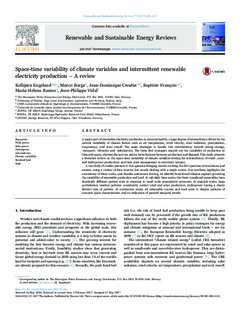| dc.description.abstract | A major part of renewable electricity production is characterized by a large degree of intermittency driven by the natural variability of climate factors such as air temperature, wind velocity, solar radiation, precipitation, evaporation, and river runoff. The main strategies to handle this intermittency include energy-storage, -transport, -diversity and -information. The three first strategies smooth out the variability of production in time and space, whereas the last one aims a better balance between production and demand. This study presents a literature review on the space-time variability of climate variables driving the intermittency of wind-, solar- and hydropower productions and their joint management in electricity systems. A vast body of studies pertains to this question bringing results covering the full spectrum of resolutions and extents, using a variety of data sources, but mostly dealing with a single source. Our synthesis highlights the consistency of these works, and, besides astronomic forcing, we identify three broad climatic regimes governing the variability of renewable production and load. At sub-daily time scales, the three considered renewables have drastically different pattern sizes in response to small scale atmospheric processes. At regional scales, large perturbation weather patterns consistently control wind and solar production, hydropower having a clearly distinct type of pattern. At continental scales, all renewable sources and load seem to display patterns of constant space characteristics and no indication of marked temporal trends. | nb_NO |

